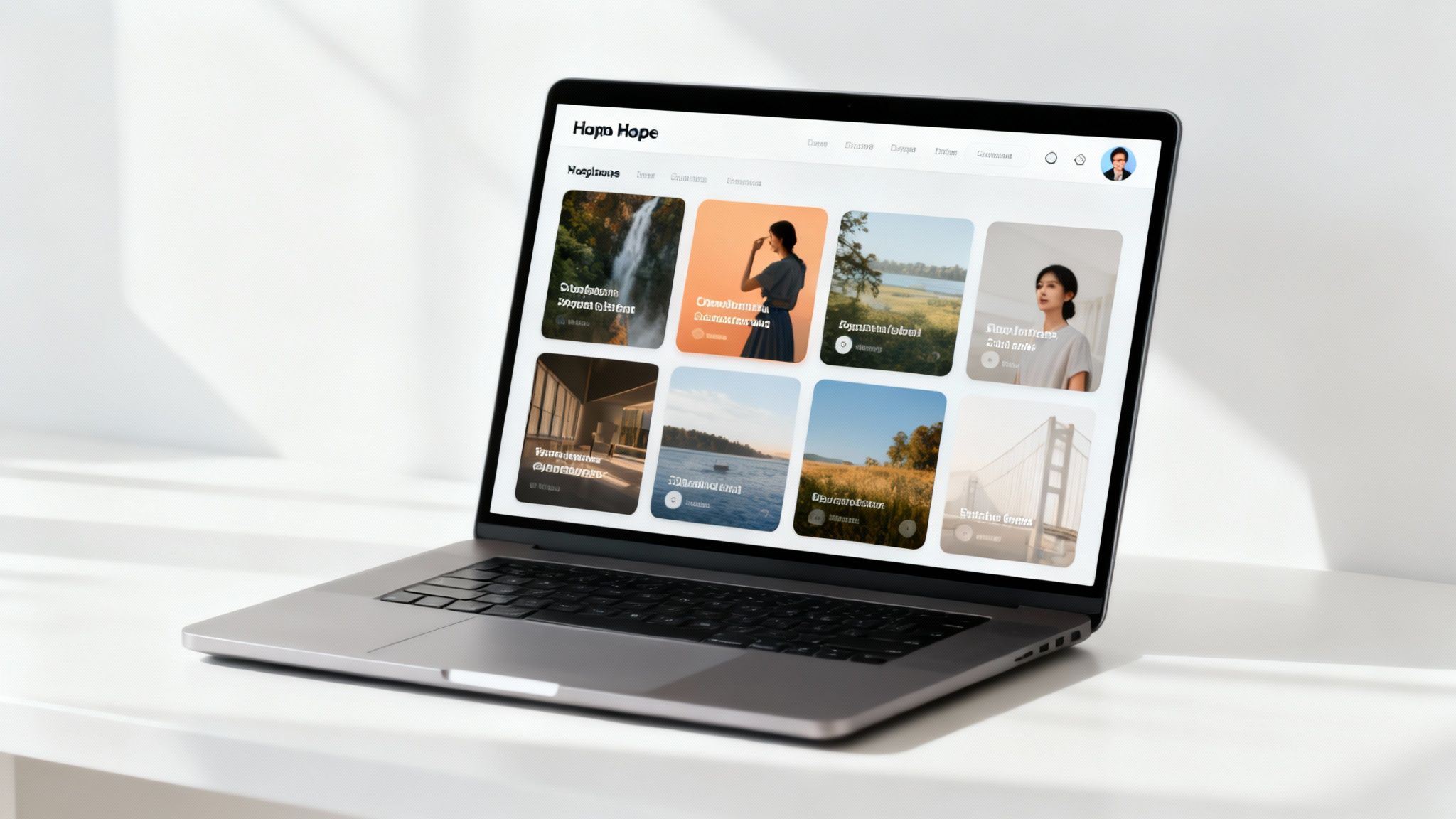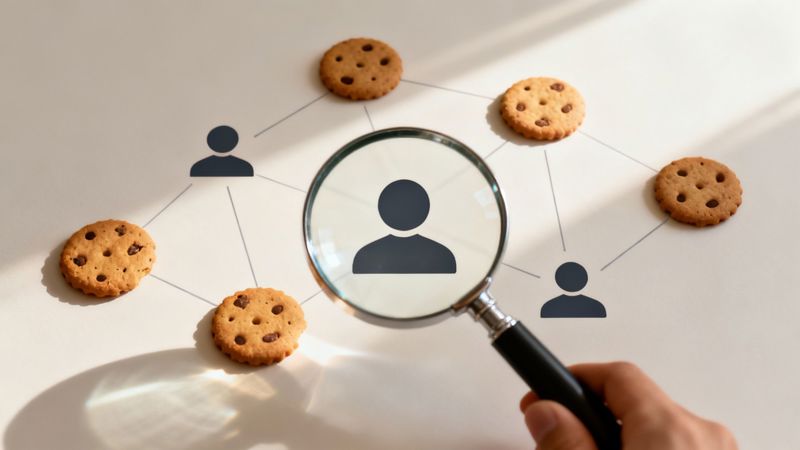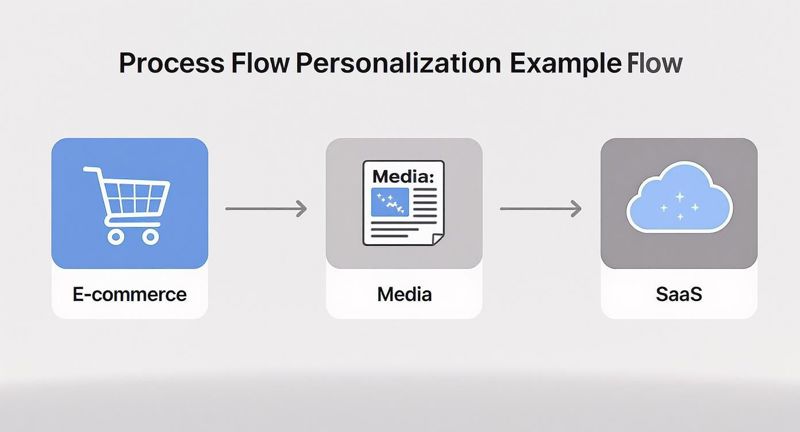Think of a personalized home page as a digital welcome mat that changes for every single visitor. Instead of serving up the same generic page to everyone, it shows the most relevant content to that specific person, right from the first click.
What Are Personalized Home Pages Really

Imagine walking into your favorite local coffee shop, and the barista already has your usual order waiting for you. That’s the exact feeling a personalized home page creates online. It’s your website’s front door, but instead of being identical for everyone who knocks, it intelligently rearranges itself to greet each visitor personally.
This is a huge leap from the old "one-size-fits-all" model, where every visitor saw the same banners, headlines, and product suggestions. Let's face it, today's users expect experiences that get them. A generic page feels impersonal and irrelevant, and people lose interest fast.
The Core Concept of Personalization
At its heart, a personalized home page uses data to make smart guesses about what a visitor wants to see. It’s not magic—it’s just a strategic way of using information to create a more helpful and engaging journey for the user.
This data usually comes from a few key places:
- Behavioral Data: What pages has the visitor looked at before? What items did they add to their cart?
- Demographic Data: Where is the visitor located? What industry do they work in?
- Contextual Data: Are they on a phone or a desktop? Is this their first time on the site?
By piecing these clues together, the website can dynamically adjust its layout and content on the fly. To get a deeper dive into creating these kinds of experiences, check out these methods for Mastering Personalization on the Web.
Why It Matters More Than Ever
In a seriously crowded digital world, first impressions are everything. A personalized home page immediately shows your visitor that you understand their needs, which builds trust and makes them want to stick around and explore. You’re essentially turning a static brochure into an active conversation.
A personalized experience makes a visitor feel seen and valued, transforming a passive browser into an engaged participant. This simple shift is fundamental to building lasting customer relationships and driving meaningful business outcomes.
For example, an e-commerce site could show a returning customer the items they recently viewed right on the home page. A B2B software company might feature a case study that’s directly relevant to a visitor's industry. These small, thoughtful adjustments make the whole experience feel more intuitive and valuable.
This kind of approach isn't a luxury for big brands anymore. It’s a core strategy for anyone looking to truly connect with their audience.
The Business Impact of a Tailored Welcome

Let's move past the theory and talk about what really matters: results. A personalized home page isn't just a "nice-to-have" feature designed to make visitors feel special. It's a hard-working business tool that delivers measurable outcomes straight to your bottom line.
Think of it this way: your website stops being a static billboard and becomes a dynamic, responsive sales engine.
The most immediate win is a big jump in conversion rates. When a visitor lands on a home page that instantly speaks to their interests or remembers what they looked at last time, the path to making a purchase gets a whole lot shorter. You’ve already brought what they want front and center, so they don't have to go digging for it.
For an e-commerce shop, this could be as simple as a "Recently Viewed" carousel or new arrivals in their favorite category. For a SaaS company, it might mean highlighting a case study from the visitor's industry. These small tweaks remove friction and nudge users toward taking that next step.
Driving Higher Revenue and Deeper Loyalty
Beyond that first sale, personalized home pages are absolute powerhouses for boosting both Average Order Value (AOV) and Customer Lifetime Value (CLV). By showing relevant product recommendations or add-on services, you can effectively upsell and cross-sell without ever coming across as pushy.
It’s like having a helpful digital assistant who anticipates your customer's needs. If someone bought a high-end camera on their last visit, why not greet them with compatible lenses or premium accessories next time? This move not only makes that specific transaction more valuable but also cements your brand as the go-to resource, which is exactly how you earn repeat business.
This kind of attention to detail builds incredible brand loyalty. Customers feel seen and understood, which makes them far more likely to come back. You start building a real relationship that goes beyond a simple transaction, turning one-time buyers into genuine advocates for your brand. This is a core part of modern marketing, and you can learn more by checking out our guide on what is personalization in marketing.
By aligning your homepage content with user intent, you don't just reduce bounce rates—you create a self-perpetuating cycle of engagement. Visitors stay longer, explore more, and are far more likely to convert, significantly boosting the return on your marketing investment.
The numbers don't lie. Recent industry data shows a staggering 96% of consumers are more likely to buy from a site that offers personalized experiences, like targeted reminders. Even better, an impressive 89% of U.S. businesses have reported a direct revenue increase after putting website personalization into practice. The financial impact is undeniable.
Gaining a Significant Competitive Edge
Let's be honest, today's marketplace is crowded. Consumers have endless options, and a generic, one-size-fits-all website is a major liability. A personalized home page gives you a distinct competitive advantage by delivering a user experience that your competition just can't match.
This customized approach shows visitors you value their time and attention. It proves you've put in the work to understand what they're looking for, which builds instant trust. The end result is a "stickier" website that keeps people engaged and makes them far less likely to click away to a competitor.
Ultimately, investing in personalization is an investment in your customers. The data proves it's not a cost but a high-return strategy that fuels growth, deepens relationships, and secures your spot in a packed digital world.
How Personalization Works Behind the Scenes

To really get why personalized home pages are so effective, it helps to pull back the curtain and see what’s going on underneath. It might seem like digital magic, but the core idea is pretty straightforward.
Think of your website as a detective. It’s constantly gathering clues about each visitor to figure out who they are and what they’re looking for. This isn't guesswork; it's all driven by data. Every click, every page view, every second spent on the site is another piece of the puzzle. When you put all those pieces together, you get a clear picture that lets the website adapt its content on the fly.
At its heart, this entire process runs on dynamic content. Instead of one static home page, different users see different things based on the clues they’ve left behind. If you're using a platform like Elementor, understanding this concept is key, and there are some great guides on mastering Elementor dynamic content that show how it's applied.
The Key Data Clues
So, what kinds of clues is your website-detective collecting? Personalization engines typically look at a few different categories of data to build a complete profile. Each one adds another layer of understanding.
Let's break down the most common data sources and how they translate into a better user experience.
Data Sources for Website Personalization
| Data Type | Description | Example Use Case |
|---|---|---|
| Behavioral | Tracks actions a user takes on your site, like pages visited, items added to a cart, or time spent on a blog post. It's the most direct indicator of what they're interested in right now. | A user who viewed several product pages for running shoes sees a home page banner featuring the latest running shoe models. |
| Demographic | Includes broader information like the user's general location (country or city) or their company's industry (for B2B sites). It provides valuable context. | A visitor from Germany is shown prices in Euros and content in German, without having to manually select their region. |
| Contextual | Relates to the "how" of their visit—the device they're using (mobile vs. desktop), the time of day, and how they got to your site (e.g., from a specific ad campaign or Google search). | Someone arriving from a Facebook ad for a 20% off sale is immediately shown a home page that reinforces that exact offer. |
By weaving these data types together, a website can stop shouting a generic message and start having a truly relevant conversation with each individual visitor. The engine behind all this is what we call dynamic content. For a deeper dive, check out our guide that explains what is dynamic content and how it powers these experiences.
From Simple Rules to Smart Predictions
Once your site gathers all this data, it needs to know what to do with it. This is where personalization engines step in, and they can range from simple, straightforward rules to highly advanced artificial intelligence.
A personalized home page works by translating user data into a tailored visual experience. It stops broadcasting a single message and starts having thousands of individual conversations simultaneously.
On the simpler end of the spectrum, you have rule-based personalization. This works on basic "if-then" logic that you set up yourself. For example: "IF a visitor is from Canada, THEN show them a banner about free shipping to Canada." It’s direct, effective, and perfect for clear-cut segmentation.
But where things get really interesting is with predictive personalization. This approach uses AI and machine learning to go beyond just reacting to past behavior. These smart systems analyze massive amounts of data to predict what a user might want next. They spot subtle patterns and can recommend products or content a user didn't even know they were looking for, making the whole experience feel incredibly intuitive. This is what separates a good website from a truly exceptional one.
Personalized Home Pages in the Wild
Theory is one thing, but seeing personalized home pages in action is where the real inspiration strikes. The best way to grasp the power of a custom welcome is to look at how top companies are already using this strategy to create smoother, more relevant experiences for their users. From e-commerce giants to global news outlets, personalization is what’s driving engagement.
These examples aren't just clever tricks; they're smart, strategic decisions designed to hit specific business goals. Each one shows a deep understanding of the user journey, using data to remove friction and steer visitors toward the most valuable actions. Let’s dive into a few.
E-commerce Giants Mastering the Return Visit
Think about your last trip to Amazon. The home page you landed on was built just for you. It wasn't some generic digital storefront; it was a curated gallery based on your past clicks, searches, and purchases. This is a classic—and wildly effective—use of personalization.
E-commerce sites nail this by zeroing in on a few key data points:
- Recently Viewed Items: A simple but brilliant reminder of products you were considering, making it easy to pick up right where you left off.
- "Inspired by Your Browsing History": This takes it a step further by suggesting related products you might have missed. If you looked at hiking boots, it might show you waterproof socks or a new backpack.
- Personalized Offers: For loyal shoppers, the home page might flash special discounts or early access to sales on brands they buy often.
This approach turns a passive product catalog into an active, helpful shopping assistant. It anticipates your needs and makes buying ridiculously simple, which is a huge driver for both sales and customer loyalty.
Media Outlets Curating Your Daily News
The world of digital media is another space where personalized home pages are making a massive impact. With an endless firehose of content, helping readers find what actually matters to them is the only way to keep them engaged and subscribed.
Major publishers have figured out that a one-size-fits-all news feed just doesn't cut it anymore. Instead, they use your reading history to build a home page that mirrors your unique interests. If you constantly read articles about technology and finance, your home page will surface stories from those sections first.
This strategy works. Publishers like The New York Times and The Washington Post have seen click-through rates jump by 30% to 50% after adding personalized "For You" sections that cater to a reader's location and interests. These results prove how a tailored content experience can seriously boost user retention. You can learn how homepage personalization sections are being tested by different publishers to innovate their platforms.
By transforming a generic news feed into a personal briefing, media companies create a stickier, more valuable product. Readers are far more likely to come back daily when they know the content will be relevant to them.
SaaS Companies Speaking Directly to a User’s Role
For Software-as-a-Service (SaaS) businesses, the home page has to serve two completely different audiences: potential new customers and existing logged-in users. A personalized home page lets them talk to each group with the right message at the right time.
Here’s how they pull it off:
- For New Visitors: The home page is all about acquisition. It might highlight a clear value proposition, show off social proof like customer logos, and feature a big, bold call-to-action like "Start a Free Trial" or "Request a Demo."
- For Logged-In Users: Once a user signs in, the home page instantly shifts into a dashboard or a resource hub. The goal is no longer acquisition but retention and upselling. The content might include links to new features, helpful tutorials, or information on upgrading their plan.
This split is incredibly efficient. It makes sure prospects get the information they need to buy, while existing customers get a streamlined experience that helps them get more value from the product. It’s a perfect example of how personalized home pages can serve multiple strategic goals at once.
Your Roadmap to a Personalized Home Page
Making the jump from understanding personalized home pages to actually building one can feel like a pretty big leap. But here's the good news: you don't need a huge dev team or a clunky, custom-built system to get started. The real key is having a clear plan, starting small, and scaling up intelligently as you go.
Think of it like learning to cook a new dish. You wouldn't dive straight into a five-course gourmet meal. You’d start with a simple recipe, get the basics down, and then slowly add more complex flavors. The same idea applies here. Your goal is a better user experience, and even small, thoughtful changes can have a huge impact.
Defining Your Goals and Segments
Before you even think about technology, you need to figure out what you're trying to achieve. A personalization strategy without a clear goal is like a road trip with no destination—you'll burn through a lot of gas without getting anywhere.
Start by asking a few core questions:
- What’s our main business objective? Are we trying to drive more free trial sign-ups, boost e-commerce sales, or keep users coming back?
- Which audience segments matter most? Should we be focusing on first-time visitors, loyal returning customers, or maybe users from a specific industry?
- What action do we want them to take? Do we want them to download a whitepaper, watch a demo, or add an item to their cart?
Answering these questions gives your efforts a real direction. For example, if your goal is converting more first-time visitors, you might show them a welcome banner with a 10% discount. Or, to re-engage returning customers, you could show them products they recently looked at. Simple, right?
Choosing Your Personalization Technology
Once you have your goals locked in, it’s time to pick your tools. The market is packed with options, from all-in-one platforms to more flexible, API-driven solutions. For a good look at what's out there, it’s worth exploring different website personalization tools to see what fits your team's needs and budget.
The tech you choose really depends on your team’s skills and how deep you want to go. No-code platforms like OKZest, for example, let marketers create dynamic experiences without writing a single line of code. This makes advanced personalization accessible to everyone and lets you focus on strategy instead of getting stuck in the technical weeds.
This infographic breaks down how personalization can be applied across different industries to hit specific business goals.

As you can see, whether you're in e-commerce, media, or SaaS, the core idea is the same: tailoring the user experience to drive engagement and conversions.
Starting Small and Scaling Up
The best personalization strategies don't just appear overnight. They start with simple, rule-based tweaks and grow from there. This step-by-step approach lets you learn what works for your audience without making a massive investment upfront.
Here’s a practical path to follow as you scale up:
- Start with Simple Rules: Kick things off with basic "if-then" logic. For example, IF a visitor comes from a specific marketing campaign, THEN show them a home page headline that mirrors the ad's message.
- Introduce Behavioral Targeting: Next, start personalizing based on what users do. Show a "Welcome Back" message to returning visitors or display recently viewed items for shoppers who left their carts.
- Layer on More Data: As you get more comfortable, you can pull in more data points, like geolocation or device type, to create even more relevant experiences.
- Explore AI-Driven Personalization: Eventually, you can graduate to predictive models that use AI to guess what users need and recommend content or products they haven't even searched for yet.
The journey to a fully personalized home page is a marathon, not a sprint. Start with a single, impactful change, measure the results, and let the data guide your next move. This methodical process ensures sustainable growth and a positive return on investment.
And people are ready for it. Surveys show that 74% of consumers get frustrated when website content isn’t personalized. Better yet, 57% are willing to share personal data for tailored experiences, and businesses that get personalization right see an average sales lift of 19%. This data makes it clear: creating personalized home pages isn't just a tech project—it's a direct response to customer demand that really pays off.
Common Personalization Pitfalls to Avoid
Getting personalized home pages right can deliver incredible results, but the path isn't always smooth. It’s easy to stumble. Simply flipping the switch on a personalization strategy isn’t enough; you have to sidestep the common mistakes that can weaken your efforts or, even worse, alienate your audience.
Navigating these challenges is the key to making sure your investment actually pays off. By understanding where others have gone wrong, you can build a strategy that's both effective and respectful of your users.
The Danger of Over-Personalization
There's a fine line between being helpful and just being creepy. When a website seems to know a little too much about a user—especially on a first visit—it can break trust instantly. This usually happens when companies get too aggressive with sensitive or third-party data, making visitors feel watched rather than welcomed.
The goal is to be a helpful guide, not an all-knowing fortune teller.
- Prioritize Behavioral Data: Stick to personalizing based on what the user actually does on your site, like pages they've viewed or items they've added to a cart.
- Start Subtly: For brand new visitors, use broader clues like their location or how they found you for some light personalization. Save the deeper stuff for returning customers who are already engaged.
Relying on Inaccurate or Incomplete Data
Another huge pitfall is building your strategy on a foundation of bad data. If your information is outdated, wrong, or just plain incomplete, your personalization efforts will completely miss the mark. Showing someone recommendations based on a one-time gift they bought for their cousin three years ago is a classic example of this.
Personalization is only as good as the data behind it. "Garbage in, garbage out" isn't just a saying for developers; it's a core principle for creating experiences people actually want.
To fix this, regularly check your data sources and make sure your collection methods are clean. You need a system that lets user profiles evolve as their behaviors and tastes change. This ensures your personalized home pages stay relevant over time.
Personalizing Without a Clear Goal
Finally, one of the most common mistakes is personalizing just for the sake of it. Changing a headline or swapping a banner image without a clear business objective is a fast way to waste time and money. Every single personalized element on your home page should be tied to a specific, measurable goal.
Before you launch anything, ask yourself: what are we actually trying to do here? Are we trying to get more free trial sign-ups? Reduce bounce rates? Boost the average order value for a certain customer group?
By defining your key performance indicators (KPIs) upfront, you can measure the real impact of your work. This turns personalization from a cool gimmick into a powerful business tool that directly helps your bottom line.
Answering Your Personalization Questions
As you start thinking about personalized home pages, some questions always seem to pop up. It's totally normal. Let's tackle them head-on, so you can feel confident about moving forward with your own strategy.
First up is the data question. Lots of people think you need a mountain of data to even get started, but that’s one of the biggest myths out there. You can absolutely start small with information you probably already have.
For example, a visitor's location, the device they're on, or how they found your site are all fantastic starting points for simple but effective personalization.
Personalization vs. Customization
Another common point of confusion is the difference between personalization and customization. They sound alike, but they're actually opposite approaches to creating a tailored experience.
- Customization is user-driven. Think about changing your social media profile theme or picking your favorite topics in a news app. The user is in the driver's seat, making manual changes to fit their own tastes.
- Personalization is system-driven. This is where the website or app does the work for the user automatically, based on their behavior and other data. The system anticipates what the user needs without them having to ask.
Customization is like a user rearranging the furniture in a room to their liking. Personalization is like walking into a room where the furniture has already been arranged perfectly for you.
Is Website Personalization Expensive?
Finally, let's talk about cost. In the past, creating these kinds of dynamic experiences was a huge undertaking that required a lot of developer time, making it a pretty expensive project.
But modern tools have completely changed the game. No-code platforms and flexible APIs have made personalized home pages accessible and affordable for businesses of any size. Now you can launch sophisticated campaigns without a huge budget or an in-house development team, letting you focus on the strategy instead of getting bogged down in the tech.
Ready to create engaging experiences that convert? With OKZest, you can automate personalized images for your emails, websites, and social media campaigns without writing a single line of code. Learn more and start for free at https://okzest.com.